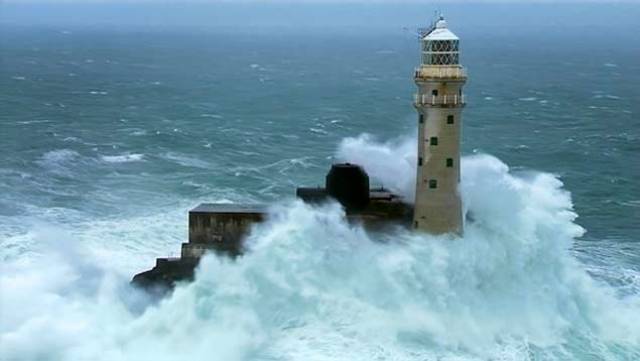This weekend forty years ago, I was the chirpy co-skipper of the smallest boat in the Cruise-in-Company fleet as we closed in on Glengarriff in far West Cork for the Golden Jubilee party of the Irish Cruising Club in the magic place where it had been founded in July 1929 writes WM Nixon.
There were boats from several organisations including the Cruising Club of America which were on a busy schedule, as several of them - and some of the Irish Cruising Club fleet too - planned to head on soon in order to do Cowes Week and the 1979 Fastnet Race, for in those days many cruiser-racers really were cruiser-racers.
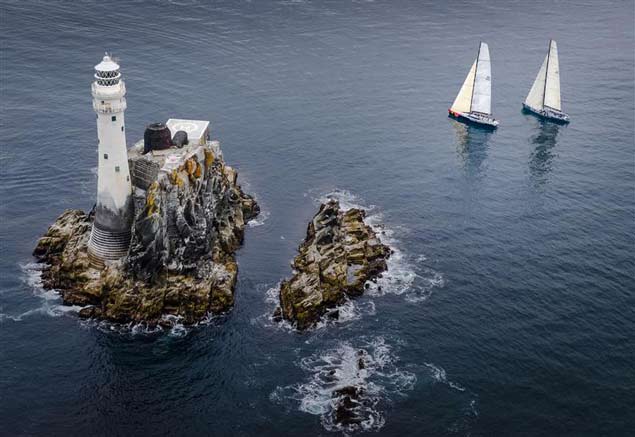 …..and the Fastnet Rock in an entirely different mood. Photo: Rolex
…..and the Fastnet Rock in an entirely different mood. Photo: Rolex
Our “smallest boat in the fleet” was the cat ketch Endeavour, prototype of the lift-keel 21ft Poacher developed by Willie and Angus Richardson of Liverpool and Holyhead. During a test sail in June from Holyhead which took us round to Treardur Bay and all the delights thereof, the idea arose that Endeavour would be just the job for participation in the ICC’s celebratory cruise-in-company. My own boat at the time was a Squib, which wouldn’t quite do for a week-long cruise from Crosshaven to Glengarriff, whereas Willie was mad keen to show his new mini wonder-cruiser to as many people as possible.
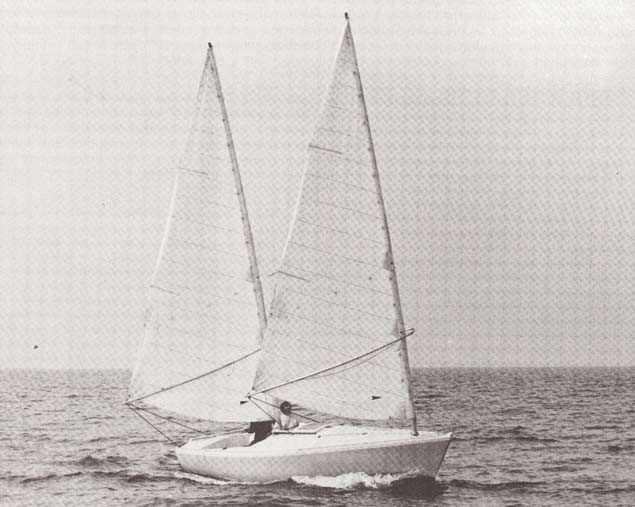 The Poacher 21 cat ketch Endeavour was the smallest boat in the ICC Golden Jubilee fleet of July 1979, but by no means the slowest. Photo: W M Nixon
The Poacher 21 cat ketch Endeavour was the smallest boat in the ICC Golden Jubilee fleet of July 1979, but by no means the slowest. Photo: W M Nixon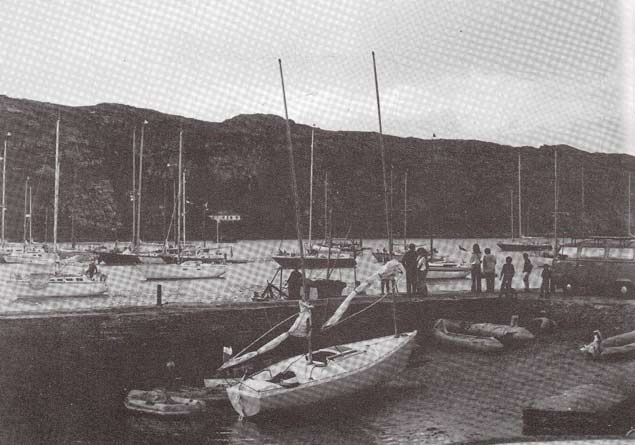 So who needs a dinghy? Endeavour at Crookhaven, with some of the Cruise-in-Company fleet moored off. Photo: W M Nixon
So who needs a dinghy? Endeavour at Crookhaven, with some of the Cruise-in-Company fleet moored off. Photo: W M Nixon
The charter fee may well have been a shilling or whatever currency we used at the time, but though modest it made our participation official, while the time economy of being able to road-trail the boat to Crosser and then trail her back again from Glengarriff suited a hyper-busy season.
For those were the glory days of the Admirals Cup, the Irish were very much to the fore, and Nixon Verbiage Industries plc were on treble overtime to keep up with everything and feed several hungry printed news outlets.
Yet as we took our farewell of friends from both sides of the Atlantic and headed up the long road from Glengarriff back to Dublin, the mood was typical of this busy though somehow also soporific mid to late summer sailing time as August approaches, with a definite shift of emphasis. Not that we’d the faintest notion that within a fortnight the fiercest storm ever to strike the Fastnet Race fleet would be gathering power to obliterate the languid weather still lingering from July. On the contrary, it was because this is the way it is with the pattern of our sailing summer.
For this is the time in the Irish sailing year when leading figures undergo something of a character change. Not quite Jekyll & Hyde, admittedly. But nevertheless with the shift of emphasis moving towards the August mood, we find those who have been at the coalface of event administration gradually re-emerge as racing participants in events elsewhere, while with others the movement is in the opposite direction.
Thus today is the final day of the WIORA Championship in Foynes, with Alan Crosbie of Kinsale as ever the Race Officer. But he and his specialists will be relying on a team of local volunteers many of whom will reappear next week as Mermaid sailors in the first-ever Mermaid National Championship to be staged by the Royal Cork YC at Crosshaven. It has all the makings of a very special event, for the Mermaids are among the most popular classes for hosting clubs – Mermaid sailors are fully aware of their duties as enthusiastic consumers – while the class is on a roll at its several centres, with new and restored boats continually augmenting the fleet.
But even as we contemplate the special interest in events in Cork Harbour, inevitably next Friday our thoughts will also be in Cowes, and the Memorial Service for those 19 people lost in the 1979 Fastnet Race tragedy. Forty years on, the freakish nature of that brief-lived but hyper-violent August storm has taken on its own mythology. But there’s no escaping the ultimate reality, and some quiet reflection next Friday is only right and proper before the huge Rolex Fastnet Race fleet sweeps westward down the Solent next day in one of world sailing’s greatest acts of waterborne choreography.
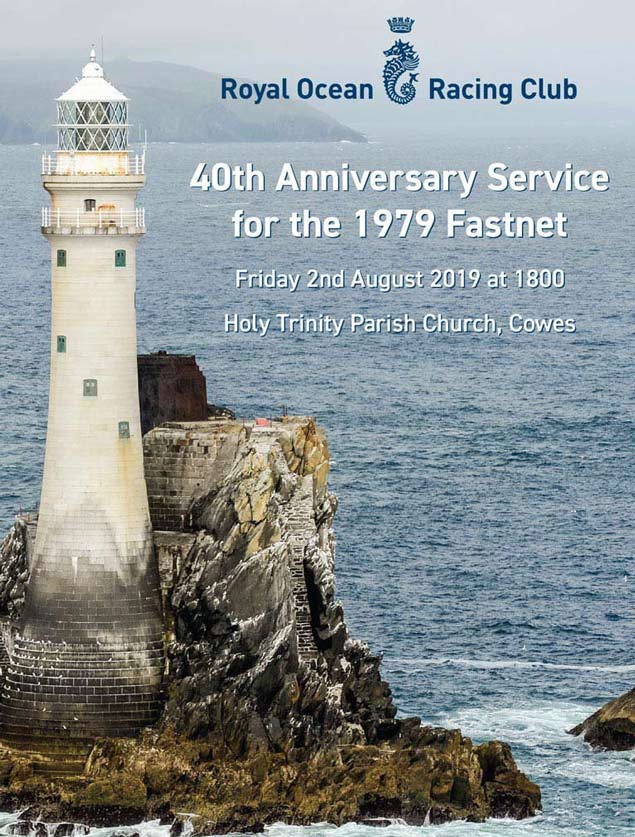 The notice for next Friday’s Fastnet Memorial Service shows The Rock with Cape Clear in the background
The notice for next Friday’s Fastnet Memorial Service shows The Rock with Cape Clear in the background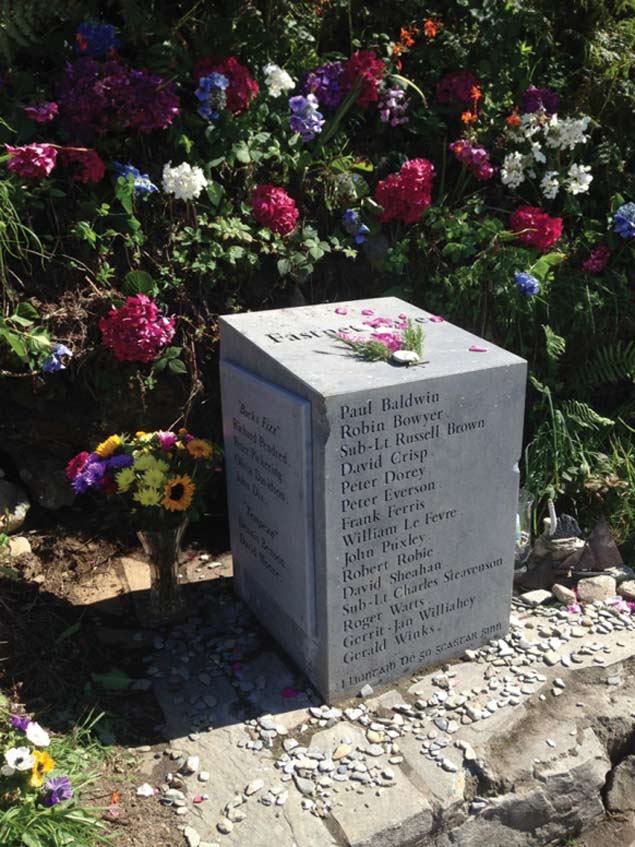 The Memorial Stone on Cape Clear
The Memorial Stone on Cape Clear
Back in 1979, it was the biggest fleet yet seen – 303 boats - but even the most experienced sailors were almost overwhelmed by their experience of the storm between August 13th and 14th. For sure, you expect the occasional gale. But this was much more than a gale.
It had so happened that during the dreamy Cruise-in-Company towards Glengarriff in July, at a couple of stopovers our little boat was berthed next to the American Swan 47 Toscana owned by Eric Swenson, who had Cowes Week and the Fastnet Race next up on his programme.
We were impressed by the owner’s determination to make the use of his fine boat as comprehensive as possible, and for the Fastnet, one of the crew was to be the noted American sailing writer John Rousmaniere. He found himself in the midst of history in the making, and his very timely book Fastnet Force 10 continues to be the definitive account of the storm and its effect, even in the face of subsequent official reports and other more personal stories.
Meanwhile, having notched a trio of Fastnets, I was more involved in parenthood in 1979, but had somehow worked it to fit in a brief family holiday in Cornwall with the In-Laws while still contriving to be up in Plymouth on the Thursday when we had anticipated reporting the Irish Admirals Cup triumph. Instead, I found myself being given an extremely personal account of the Fastnet Storm 1979 by overall winner Ted Turner in a corner of the bar in the Post House Hotel. But for reasons of State Security, the outcome of that conversation is under wraps under the Official Secrets Act until at least 2029, and probably later.
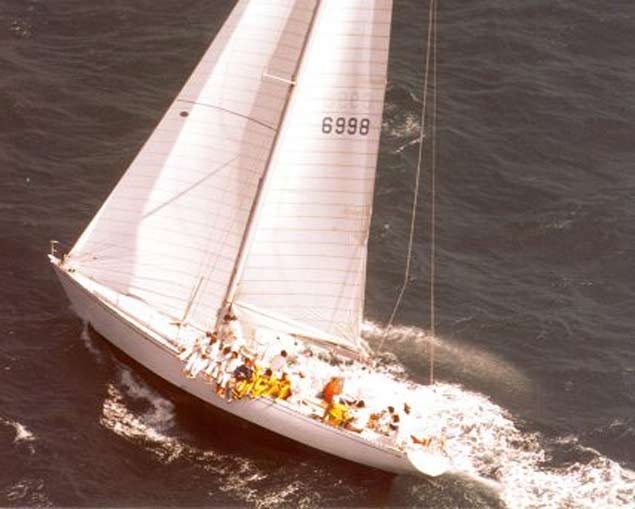 Ted Turner’s 63ft S&S design Tenacious, overall winner of the 1979 Fastnet Race
Ted Turner’s 63ft S&S design Tenacious, overall winner of the 1979 Fastnet Race
However, one of the best accounts of experiencing the Fastnet Storm is found in designer Ron Holland’s “All The Oceans”, the monumental but fascinating Memoir he published last year. The sheer variety and achievement of the talented New Zealander’s roller-coaster life is shown by the fact that the storm, which directly affected a significant number of his most successful boats at the sharpest end of the Fastnet fleet, is just another episode in a career in which he was based in Ireland for forty years - in Currabinny and then Kinsale - while creating a global design practice.
That said, the storm had a profound effect on him as it had on everyone else who came through it, and his account of experiencing it aboard Hugh Coveney’s 43ft Golden Apple of the Sun – which he had of course designed, while Killian Bushe in Cork was the builder – is one of raw candour.
Golden Apple was the senior member of the Irish Admiral’s Cup team – the other two were 39 footers, Ken Rohan’s Regardless which Holland had also designed, and the Peterson-designed Rogers 39 Inishanier (Barry Bramwell & Brian Buchanan) – and the team had gone into the Fastnet Race at the end of Cowes Week well ahead in the Admirals Cup points table, with Regardless the top scoring boat.
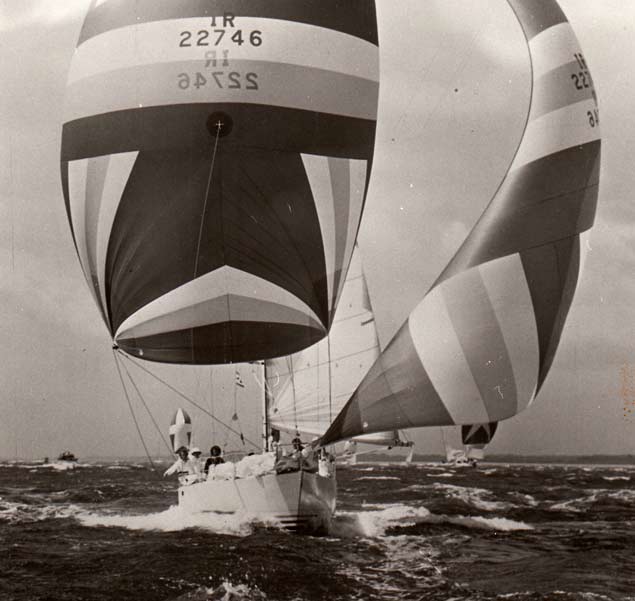 Ken Rohan’s Regardless (RIYC) racing in the Admirals Cup in the Solent in 1979. Going into the Fastnet Race, the Ron Holland-designed Regardless was the top-scoring boat in the AC, while Ireland was the leading team.
Ken Rohan’s Regardless (RIYC) racing in the Admirals Cup in the Solent in 1979. Going into the Fastnet Race, the Ron Holland-designed Regardless was the top-scoring boat in the AC, while Ireland was the leading team.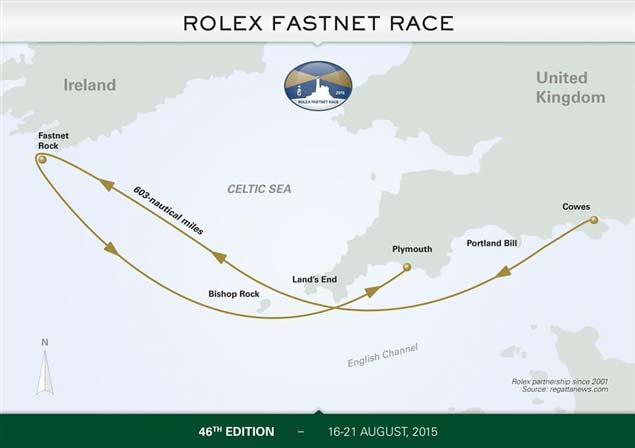 The Fastnet Race course
The Fastnet Race course
With the Fastnet Race scoring extra points, things were looking good for all the team on the second night out as they approached The Rock, but by the time the storm had gone through completely, only Inishanier was still racing. Regardless had been an early faller when her carbon-fibre rudder stock broke off at The Stags at Toe Head, and she was saved by the Baltimore Lifeboat. But Golden Apple, having rounded the rock, was still very well placed while heading for the next turn at The Bishop Rock. Ron Holland’s account well captures the way it was that night and into the next day. He takes up the story as darkness draws on and Golden Apple, with himself on the helm, is slugging into winds already gusting well above 40 knots, approaching The Rock on port tack:
“The image of The Rock that evening is burned into my memory. As we bore down on it the lighthouse keepers switched on the beam, sending a ghostly wagon wheel of yellow spokes across the white water. I steered directly for the lighthouse, estimating that the yacht’s leeway would push us clear of the turmoil before we prepared for the rounding. Since I was on the helm, it was my call and I had made a decision.
Big as the seas were, I was determined to take Golden Apple as close as I dared and slip inside the few other yachts that were lying just ahead, their stern lights coming and going in the breaking waves. I had noticed that though they were much bigger than us, they were standing further out to sea and giving The Rock a wider berth. I knew what I was doing, or at least I hoped I did. Familiar as I was with these waters, I had never before rounded The Rock in a full gale.
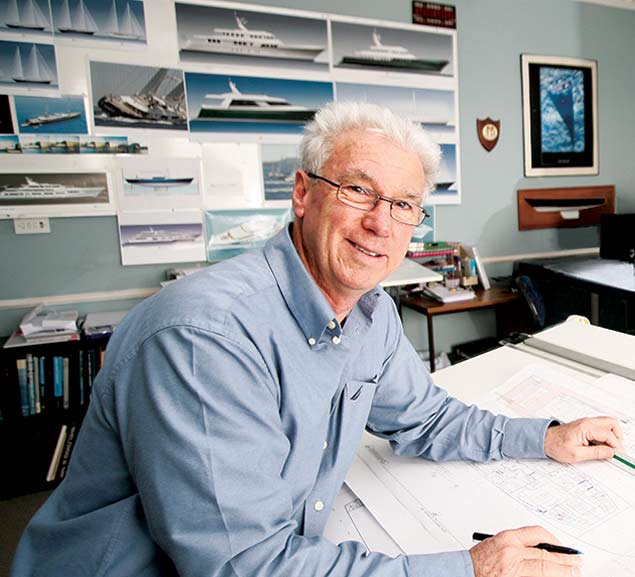 Ron Holland today. In a design career spanning more than 50 years, he has worked his way through many commissions from Quarter Tonners and even smaller craft to some of the world’s largest superyachts
Ron Holland today. In a design career spanning more than 50 years, he has worked his way through many commissions from Quarter Tonners and even smaller craft to some of the world’s largest superyachts
Keeping the lighthouse to port, I steered for the white water. I caught a few concerned glances from the crew as the yacht hit violent cross-currents from the waves smashing back from the rocks, and began to buck and heave like a bronco. I gripped the wheel as hard as I could, and others clung to any handhold they could find.
Judging the moment, I yelled “Ready about”, and threw the wheel over, flipping Golden Apple onto starboard tack for the rounding. The crew scrambled up to the starboard side and prepared to ease the sheets as soon as we cleared The Rock and the lighthouse. I glanced under the boom and saw for the first time the space between us and The Rock. All of a sudden it seemed a little too close for comfort.
On her new tack, the yacht took a few seconds – too many seconds – to get back up to speed. The helm felt soft as the rudder struggled to bite in the foam and froth. Glancing back, I could see a black trail that out passage had carved into the whiteness. I was struck by a fleeting through that the other yachts outside us were probably watching and wondering if we had taken leave of our senses.
Eventually, Golden Apple picked herself up, and although thrown about like a toy, began to plough her way through the turmoil. “That was a bit scary”, I thought.
A soon as we were clear of The Rock, we set a course for the Scilly Isles……Looking back in the gathering darkness, I could make out the other yachts far behind us. “We just killed those guys” I yelled. And I was right. Later we would learn that the lighthouse keeper had recorded us as leading the race on corrected time.
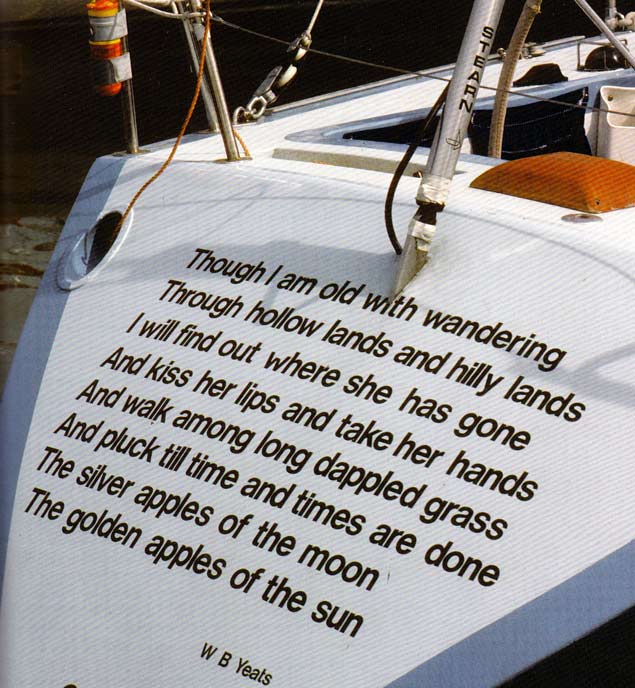 Poetry in sailing……Golden Apple of the Sun’s famous transom
Poetry in sailing……Golden Apple of the Sun’s famous transom
Tired from my stint on the helm, I handed the wheel over to Harry Cudmore for his one-hour trick: it was impossible to concentrate longer than that…………. Golden Apple tore into the night like a scalded cat.
Right through the darkness, there was no let-up from the conditions, and at dawn, the wind was still screaming with gusts shrieking through the rigging at 60 knots or more…..I had never seen seas like these……They marched over the horizon, white water tumbling over the top as though they were breaking on a beach….throwing Golden Apple around like a rag doll. Line after relentless line they stretched……There was no reprieve.
Steering Golden Apple had become a gamble with disaster…..you’d to treat the boat as though she were a 15-ton surfboard. You’d to angle her down the wave so she didn’t bury her nose in the bottom of the trough, or she might somersault stern over bow…when a yacht pitchpoles, anything can happen…..
When I’d finished my latest turn on the helm I went below, not to sleep because that was out of the question, but just to lie down, even if my head was resting on a soaking wet pillow. My back and arms were aching from two days and nights of turns on the wheel. And I was sore and bruised from a fall. It had happened while I was relieving myself over the side while clinging to the backstay – the standard procedure – when somebody yelled: “Breaking wave!” “Jeez, it must be a big one”, I thought. “Aren’t they all breaking?” And then it hit, knocking me clean off my feet. If it hadn’t been for my crewmate Neil Kenefick, it would have been worse. Reacting fast, he grabbed me and threw me unceremoniously to safety in the bottom of the water-filled cockpit.”
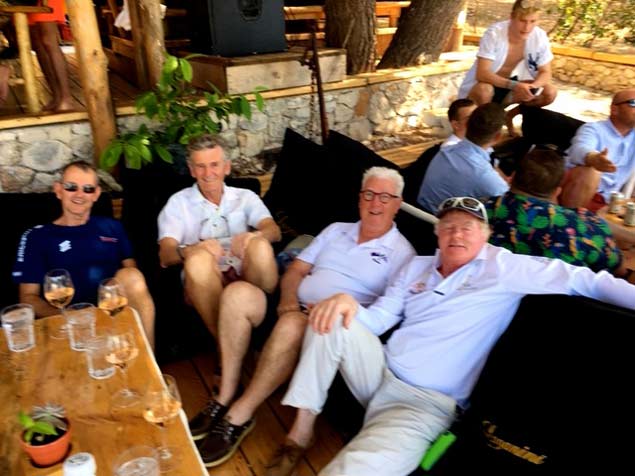 Forty years down the line – Ron Holland and his saviour Neil Kenefick (right) relaxing with two shipmates during a cruise in Croatia earlier this month. Photo: Harold Cudmore
Forty years down the line – Ron Holland and his saviour Neil Kenefick (right) relaxing with two shipmates during a cruise in Croatia earlier this month. Photo: Harold Cudmore
Golden Apple was moving fast and staying with the storm, and all the time the sea was becoming even more rough and confused. The noise below was unbelievable. Ron persuaded his shipmates that they had to slow the boat back and for a couple of hours they were under a lone storm staysail. Then at last conditions began to ease, and they were soon in full racing mode again, albeit still heavily reefed.
Ron continues: “Taking another turn on the helm, I kept a wary eye astern for a rogue wave, the one that can so easily catch you by surprise. Although we might be over the worst of the storm, the seas remained monstrous. I’d not been long on the helm when somebody shouted above the screaming of the wind: “Big wave coming!” It had become a familiar warning but I remember thinking once again: “Jesus, this must be a beauty”.
Crash! A wall of white, grey and turquoise water – I still remember the colours – broke over us and knocked Golden Apple straight onto her beam ends. I wrenched the wheel hard to stop her broaching and lying side-on to these huge waves, a dangerous position for boat and crew. In my anxiety, I must have overdone it. Above the din of wind and waves, I heard a loud bang. With a sinking feeling, I immediately knew what had happened. The carbon fibre rudder shaft had snapped. Confirming my fears, the wheel went limp in my hands”.
Golden Apple’s race was over, but by this time a massive rescue operation was underway through much of the fleet, and as they’d got so far on their way to the Scillies, it was a Cornwall-based SAR helicopter which came by and gave her crew the difficult decision to accept crew retrieval as they struggled with limited success to implement emergency steering. Owner Hugh Coveney, like his shipmates, was game to struggle on. But the SAR pilot gave him a take-it-or-leave-it option, while warning of a new gale approaching to sweep them in among the maze of rocks which make up the Isles of Scilly. So crew safety became paramount and they were soon brought ashore, with Hugh Coveney the last to be lifted into the helicopter.
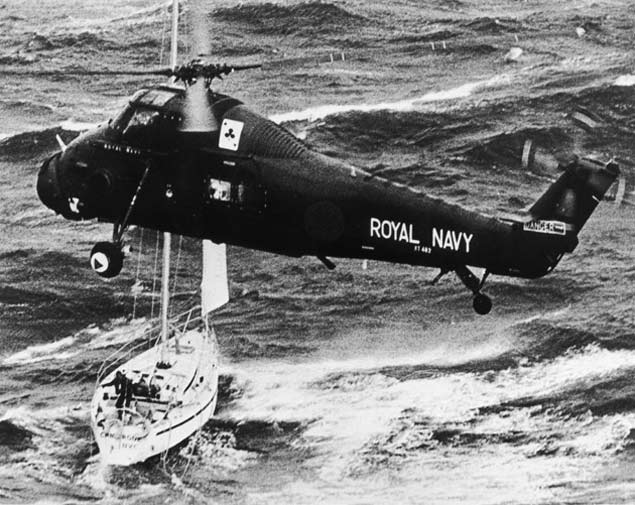 The SAR Helicopter crews were hyper-busy throughout the emergency
The SAR Helicopter crews were hyper-busy throughout the emergency
Compared to the fatal outcomes which several boats experienced, the situation of Golden Apple’s crew served instead to emphasise the extremity of the weather. This was one of the most accomplished crews in the entire fleet. Yet even they had never experienced anything like it.
But despite their brutal choice with the helicopter overhead, Golden Apple drifted clear of the rocks of the Isle of Scilly. Eventually, she was brought in to Hughtown in the Scillies by a fishing boat. Since then, it’s believed new owners have taken her on a round the world cruise.



























